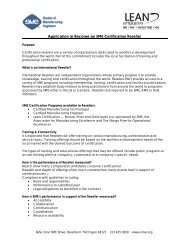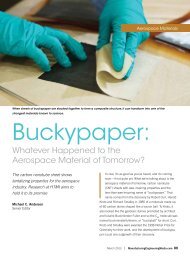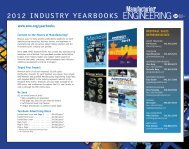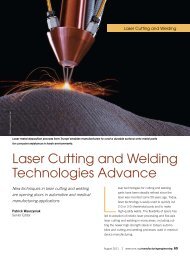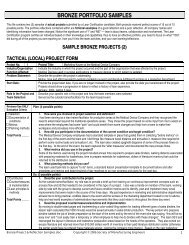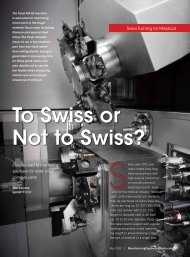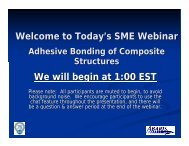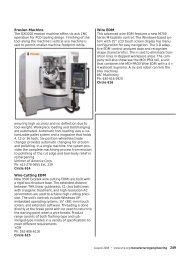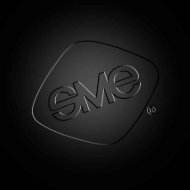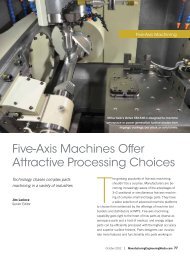The RAPID 2013 Conference & Exposition Directory - Society of ...
The RAPID 2013 Conference & Exposition Directory - Society of ...
The RAPID 2013 Conference & Exposition Directory - Society of ...
Create successful ePaper yourself
Turn your PDF publications into a flip-book with our unique Google optimized e-Paper software.
presentation will cover the intersection <strong>of</strong> design, technology,<br />
and manufacturing in the Age <strong>of</strong> Trillions.<br />
2:30–2:55 pm<br />
Advantages <strong>of</strong> Selective Contour Photocuring (SCP)<br />
Technology for Additive Manufacturing<br />
Martin Forth, Vice President, EnvisionTEC GmbH<br />
Selective contour photocuring (SCP) is a promising new<br />
technology which enables high-speed curing without sacrificing<br />
accuracy, yielding higher productivity as well as better control<br />
over material shrinkage during the build process. In a build area<br />
<strong>of</strong> 279 x 198 x 203mm, SCP technology enables a build speed<br />
up to 10mm per hour for the full build envelope at 50 microns, Z<br />
resolution inversely proportional to the X dimension, and 20 mm<br />
per hour for half <strong>of</strong> the X/Y build envelope.<br />
Curing speed is 1.5 inches per second in the X dimension,<br />
while up to 2000 partial images are cured per second in the Y<br />
dimension during X motion, enabling X/Y feature resolution down<br />
to 19 microns. Resolution in the Z dimension is 25–100 microns,<br />
depending on material, and may be adjusted by the user. In<br />
addition, viscosity <strong>of</strong> the material is no longer a constraint with<br />
SCP: liquid photopolymer may be filled with zirconia, aluminum<br />
oxide, carbon fiber, or other suspended materials. Notably, such<br />
materials may not be jetted; jet technologies require the use <strong>of</strong><br />
materials below 60 centipoise (cP) dynamic viscosity. Viscosities up<br />
to 3000 may be accommodated (e.g., EC500 wax-based material).<br />
3–3:25 pm<br />
Design Innovation Enabled by Additive<br />
Manufacturing<br />
Prabhjot Singh, PhD, Manager, GE Global Research<br />
Additive manufactring is enabling new degrees <strong>of</strong> design freedom<br />
previously not possible in new product developments. GE<br />
reseachers have been working on additive technologies for two<br />
decades. <strong>The</strong> company's level <strong>of</strong> activity and investments in additive<br />
have substantially increased during the past five years, as it<br />
has recognized the vast potential <strong>of</strong> this technology to transform<br />
its own products.<br />
This presentation will provide examples across GE's industrial<br />
portfolio in aviation, health care, oil & gas and more <strong>of</strong> how GE<br />
researchers are exploiting this capability across its product<br />
portfolio to achieve higher levels <strong>of</strong> efficiency and performance in<br />
its products and manufacturing operations. <strong>The</strong>re will be discussion<br />
on GE's efforts to foster an ecosystem that accelerates the<br />
growth and scale up <strong>of</strong> additive manuacturing to meet the largerscale<br />
industrial needs <strong>of</strong> companies like GE to maximize the<br />
impact this technology can have in transforming manufacturing.<br />
In competing technologies, use <strong>of</strong> the X and Y galvanometer<br />
mirrors creates distortion in two dimensions during the curing<br />
process. This distortion <strong>of</strong> the beam as it is reflected <strong>of</strong>f<br />
galvanometer mirrors must be corrected in both the X and Y<br />
dimensions. With SCP, optical correction is only required in the<br />
Y dimension, yielding a more streamlined build process as well<br />
as simpler long-term machine maintenance. <strong>The</strong> non-projection<br />
light source is reliable, requires no calibration over long periods<br />
<strong>of</strong> time, and allows for better control <strong>of</strong> the curing path. Higher<br />
uptime, lower maintenance costs, greater affordability, and<br />
enhanced Quality/Reliability/Durability (QRD) are the result.<br />
Image courtesy Jim Stanis<br />
6/<strong>2013</strong> – <strong>RAPID</strong> 55





